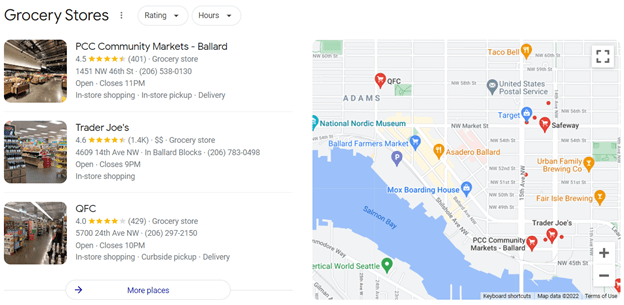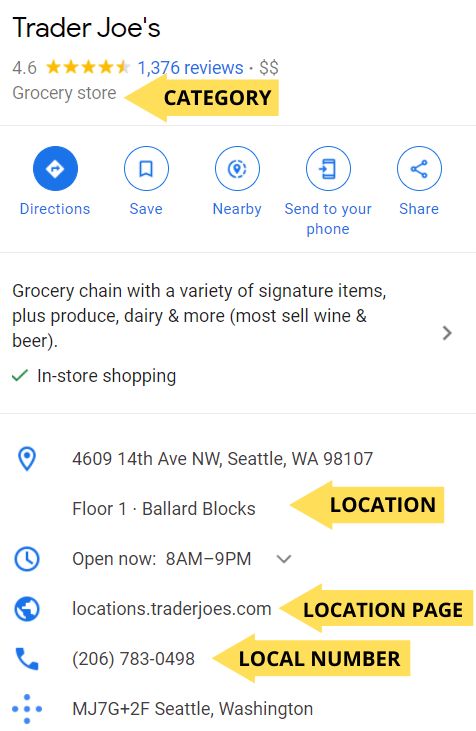The world is more connected than ever and the exchange of goods and services, for many businesses, can be facilitated almost anywhere. Because of this, it can be tempting to feel like you can — or even should — broaden your online marketing scope to focus on a national or even global scale.
Yet despite the fact that businesses theoretically shouldn’t all have to depend on local customers anymore, it’s the locals who still disproportionately affect business more often than not. This is reflected even in the digital space, where locality should in theory be at its least important.
Even just going by general Google searches, per GoGulf almost half of all of them are people looking for local information — 46% to be exact.
In the same vein:
- Of those users who searched for local results, 72% of them who made a purchase did so within five miles, per HubSpot Marketing Statistics
- 78% of location-based mobile searches result in a purchase made offline in-store, per SEO Tribunal
- And 88% of mobile searches for local businesses call or visit within 24 hours, per Nectafy
Similarly, searches for businesses, services, or products “near me” — especially on mobile — have come to dominate Google. This trend continues to grow exponentially.
Really, this is all a long-winded way of saying: While you have the whole world at your fingertips when advertising online, chances are your best bet is still the people closest to you.
What factors into local search rankings?
There are two different ways to appear in local searches — through Google Maps or general search listings.
For Google Maps, this is centered around the Local Pack/Local Finder concept; when you search for something on Google Maps, you’ll see among the results three that are highlighted with text labels and larger icons. We call this the “three pack.” Intuitively, you need to rank within the top three slots in that area and category to appear in the three pack on Google Maps.
Screenshot of a Google Maps search for grocery stores in Fremont, Seattle, WA.
For both Local Pack Google Maps and local general search listings, ranking highly generally depends on many of the same things. Both take into consideration, among other things:
- Your Google My Business profile
- Link signals, both internal and external
- Reviews
- Site engagement
- On-site optimization
- Citation building
- Social signals
Otherwise, they also consider personalized factors related to the user doing the search. Mostly, these are related to their location — either way, that’s something you don’t have control over, so don’t fret it.
Optimizing for these factors
While you don’t have control over those personalization factors, you do have various levels of control over the other ones. It’s up to you to make sure those are performing as well as possible.
First off is making sure your Google My Business profile is doing all it can in your favor. This starts by having your NAP — name, address, and phone number — well established and rock solid. Ideally you don’t ever make changes here; if you must, however, at least try to limit them to only when they’re absolutely necessary.
On a related note, resist the temptation to use a tracking phone number on your listing. Generally, you’ll be better off and more legitimized with a local phone number that matches the number on your site.
Similarly, if your business has multiple locations, it’s a smart move to have the neighborhood in your listing so that people know exactly what they’re looking at and if it matches where they need it.
As for the primary category in which your business is classified, what fits best? A good way to analyze this is, if you’re in the vicinity of your business’ location, to do a “____ near me” search for business categories in which you could fall. (Alternatively if you’re not near your business, you could do the same search but with the name of its neighborhood in the place of “near me.”) When you do this search, what categories are the top ranked listings listed as? It’s working smarter not harder to emulate these businesses’ strategies, since they’re proof of concept for what Google prefers in its rankings.
Screenshot of a Google My Business listing with NAP fields represented.
Depending on your category, Google offers different attributes you can include with your business. This includes options like whether you have free wifi, on-site parking, gender neutral bathrooms, and lots of other options.
If, after your primary category, there’s another way to categorize your business that you’d like to use too, the secondary category feature is available. Selecting this means Google will still register it in their backend, and sometimes will show it to users searching for something specifically relevant to that secondary category.
Your business description itself should include plenty of relevant keywords. These should speak directly about your business. For example, a coffee shop might want to include different roasts they offer, espresso menu options, food or baked good partnerships, and interior or atmosphere descriptions. And also make sure your hours are up to date! This includes holidays or any other special hours throughout the day — for example, a restaurant would benefit from including happy hour, brunch, etc. if applicable.
Meanwhile, URLs on your Google My Business profile should lead to your website. We highly recommend using UTM parameters here, too, since that allows for granular metrics in Google Analytics (and other analytics platforms) that allow future you to better understand what’s working for you and what’s not.
Most importantly — and like so much in the digital marketing world — getting your local SEO efforts and Google My Business profile right isn’t a one-time, set and forget thing! You need to actively watch over your profile and update it when necessary. One thing to watch out for is that Google will often encourage members of their Local Guide program to answer questions about local businesses like yours. That means that sometimes you’ll get people answering questions about your business that might be less-than-knowledgeable, and sometimes even straight incorrect. This user-generated content will be highlighted in orange — we recommend checking for new content and accepting or rejecting the suggestions regularly.
Lastly, engage with users! When people have questions, answer them, and take the time to engage with reviews. Not only does it help humanize the team behind your business, but it also makes people feel heard and shows them that you care about their experience and your relationship with the community that supports you.
It’s important to know how to make the most of your Google presence to help inform the community who’s the backbone of your business. By giving locals a clear picture of how you can serve them, you’re ensuring you end up with satisfied customers, heightened visibility for your brand, and an overall symbiotic relationship with the community.






